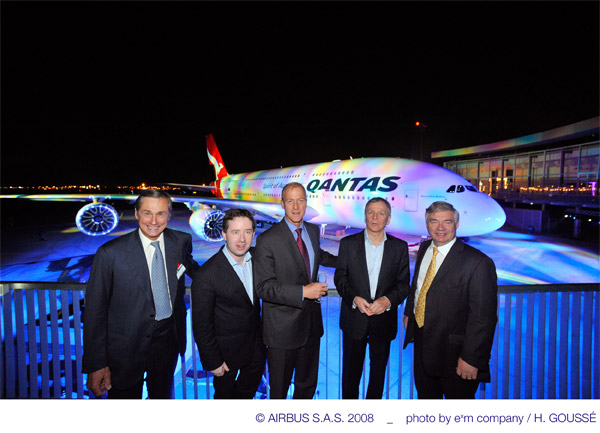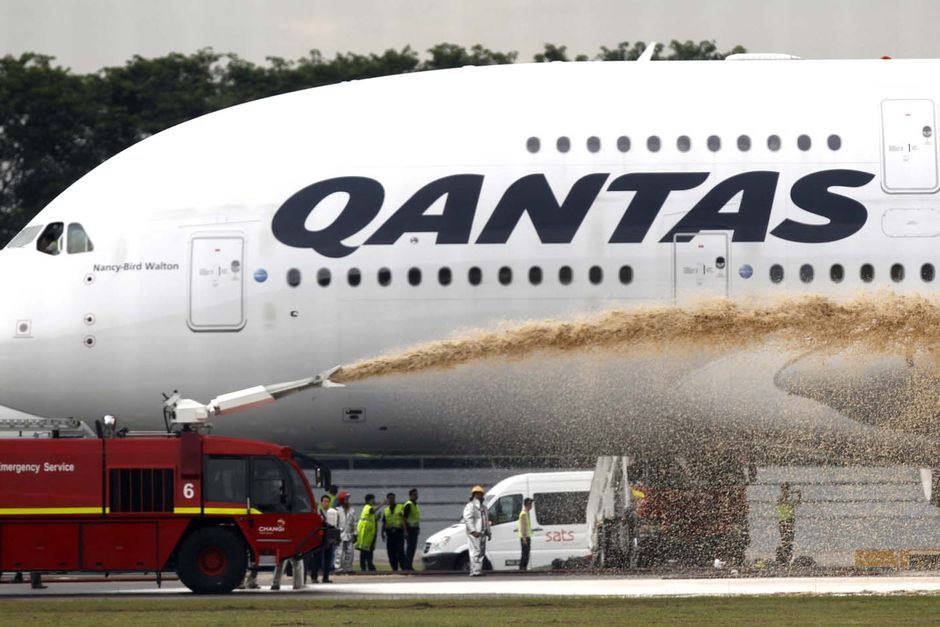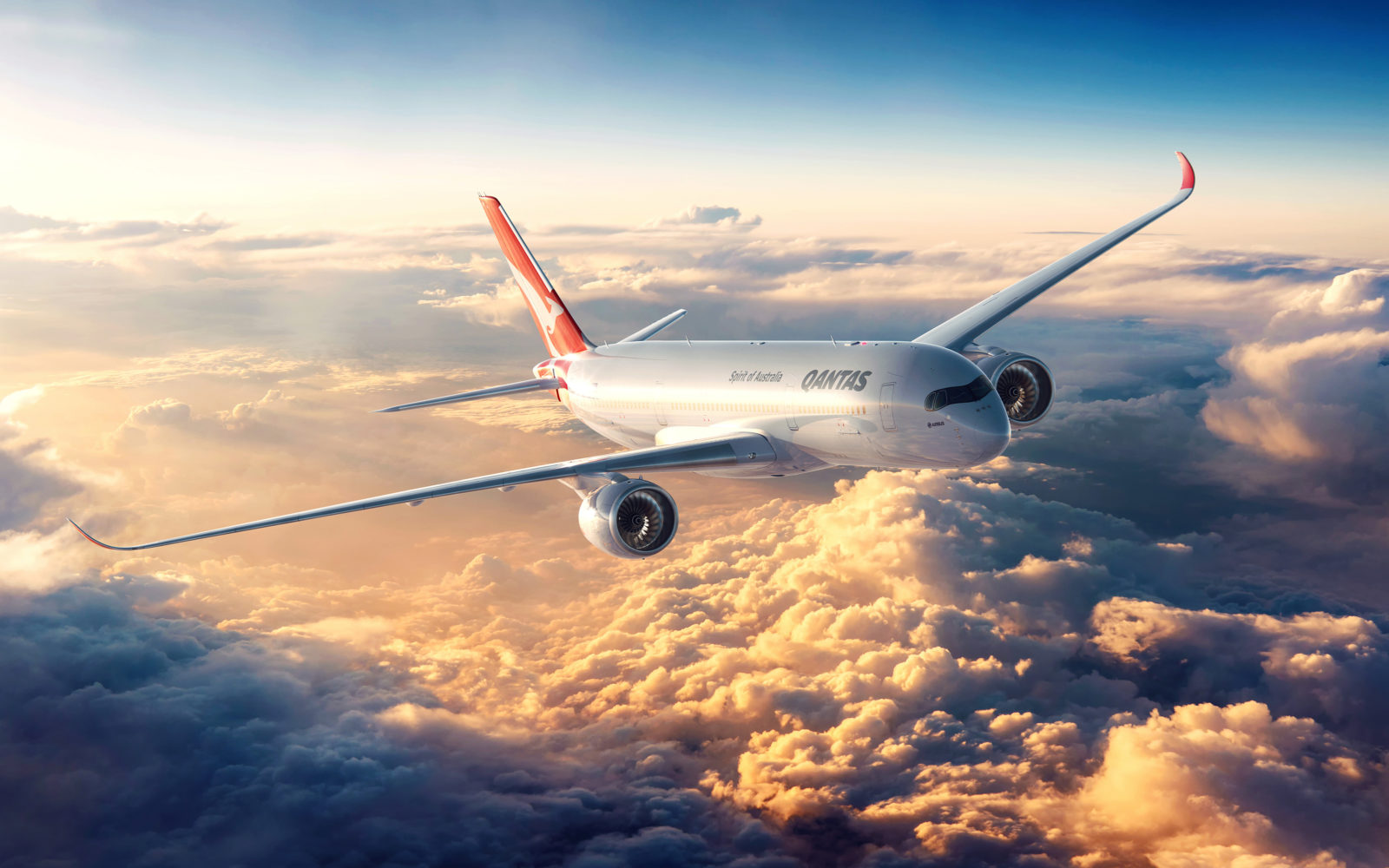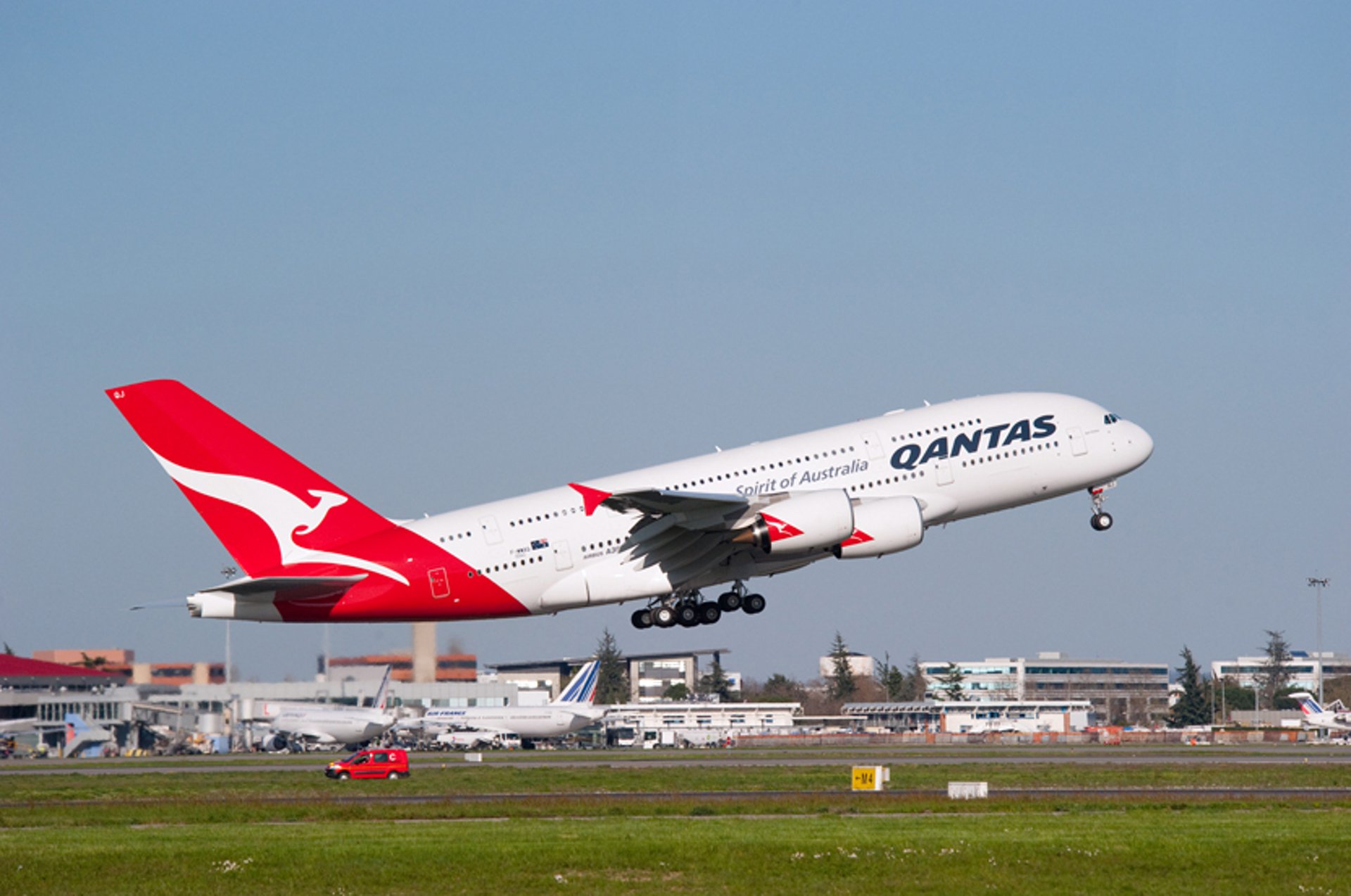On This Day: Qantas’ first A380 is handed over
On this day, 10 years ago, Qantas became the third operator of the Airbus A380, with the first of their fleet landing in Sydney.
VH-OQA was officially handed over to the airline on the 19th of September, 2008 during a delivery ceremony in Toulouse where various performances were viewed, speeches made and champagne bottles unleashed. At the time of the handover, Qantas’ CEO was Geoff Dixon. He was the one that stood by the A380 during its development and got Australia hyped up for the revolutionary new aircraft. Alan Joyce who we know as the current CEO of Qantas, was also at the ceremony as the CEO designate. The arrival of the aircraft in Sydney at 9:00am on the 21st of September marked the end of the eight year wait.

Originally ordered by the airline on the 29th of November, 2000 as an aircraft that was yet to be launched and dubbed the A3XX, the A380 would soon become subject of media probing and financial distress for both Airbus and Qantas whilst still being an amazing sight in Australian skies. One month later, Airbus confirmed that Qantas had become the first to sign a firm order for the aircraft, opting for Rolls-Royce Trent 900s to power their fleet.
With no previous experience with any Airbus products other than a couple of A300s that lacked any fly-by-wire systems acquired during the merge with Australian Airlines, the media saw Qantas’ choice as bold and risky, especially considering the aircraft was nothing but a paper plane in the hands of the skilled engineers at Airbus.
The not-so-easy delivery lead up
Qantas had set 2006 as the year of first delivery when they originally ordered the aircraft. Problems with the aircraft during design and construction stages pushed this back further to 2008, leaving Qantas in a position where they used the delays to squeeze a little honey out of Airbus.
The airline received financial compensation from Airbus valuing over $200 million and a discounted order for four additional A330-200s.
Being one of the launch customers for the A380 and being the first airline to sign firm orders, Qantas would have received substantial discounts for the type, possibly exceeding 30%, which is a lot considering the US$230 million list price at the time.
So what were the problems causing the delays?
Before the aircraft was even certified, problems regarding wing strength arose when Airbus failed to meet the 150% wing loading test. Modifications and a short delay later saw Airbus continue successfully through the test campaign. Other minor faults existed but that’s the same for most new aircraft.
Early A380 production builds were plagued with electrical and wiring issues that ultimately required rework for built frames and a redesign for future frames. The problem was tracked down to the German and Spanish sides using different software versions compared to the French and British sides. This impacted the 530km of wiring and the 98,000 connectors within the aircraft.
Customer specific issues involved cabin fitting issues and supplier issues which pushed the delivery back a further month than the initial planned date. Contingency plans were in place but such a large investment meant the airline was eager to get their hands on the jet.
Delivery
When Airbus was finally ready to hand over the aircraft, Singapore Airlines and Emirates had to receive theirs first but the main attraction in Australia was obviously Qantas receiving their first super jumbo.
Nancy-Bird Walton was displayed gracefully through the stage at the Airbus Delivery Center in Toulouse, with light shows and videos being displayed on the exterior of the fuselage. Here are some old videos from Airbus and Qantas back when the delivery occurred:
The aircraft departed Toulouse on the 20th of September, made a technical stop at Singapore Changi Airport before arriving at Sydney Kingsford Smith airport on the 21st of September, 2008. Between this date and 2011, the remaining 11 aircraft were delivered.
As part of any new aircraft introduction in an airlines fleet, crew training and familiarization was key so the aircraft didn’t actually enter proper service until October 20th, 2008 – the date of which it commenced its first international, long-haul flight full of paying passengers. The flight between Melbourne and Los Angeles was the beginning of the A380 network, with Sydney to LA, Sydney to London via Singapore and Melbourne to London via Singapore.
The Sydney to Dallas flight had the Boeing 747-40ER removed in favor of the A380 which could operate the flight with more payload. At the time it was the longest non-stop commercial flight.
The Big Bang
QF32 is one of the most notable incidents within recent Australian aviation and is definitely the most serious for the A380.
The aircraft was performing flight QF32 from Singapore to Sydney had just taken off from Changi Airport on the 4th of November 2010 when the number two Rolls-Royce Trent 900 engine suffered from an uncontained engine failure – something the pilots are trained to deal with….. If its a normal uncontained failure.
The engine had taken out various critical systems within the wing, damaged the fuselage and left the aircraft’s central nervous system in shock. Five pilots were onboard at the time of the incident: Richard de Crespigny, David Evans, Mark Johnson, Matt Hicks and Harry Wubben – all of which described the incident as challenging and scary as the aircraft was in a situation that is not tested for and put everyone in an unprotected environment.
Computers that operate the aircraft were flooding the cockpit with alarms, messages and errors due to the damaged components within the wing and engines. The pilots battled with the issues and made a safe landing back at Changi Airport.
This wasn’t the end. Upon landing, the pilots could not shut down one of the engines. No matter what they tried, the engine refused to shutdown. It took fire crews to flood the engine with water and foam to get it to flameout. After everything was secured, the passengers and crew could evacuate and the investigation could begin.
Here are some photos from the landing:


Captain Richard de Crespigny explained to media at the time of the event that they were operating in an environment that was uncontrolled, untested and outright scary. Despite this, he explained that due to the engineering expertise poured into the design of the aircraft, it held on and brought everyone back to the ground safely.
With answers being demanded by Qantas, and Airbus and Rolls-Royce not yet ready, Qantas grounded their fleet of A380s until they were assured they were safe to fly. In the meantime, engineers spent a year returning Nancy back to an airworthy state.
The cause of the incident was a manufacturing flaw in one of the oil stub pipes. A fatigue crack led to oil leaking into the engine and starting a fire, which in turn, led to the separation of the intermediate pressure turbine disc (IPT). The full report can be found here.
Media covered this incident wildly and probed Qantas, Airbus and Rolls-Royce intensely, demanding answers and wanting every bit of information. Shares fell on all sides and continued to do so for a bit.
Compensation was provided by Rolls-Royce (AUD$95 million) and wing repairs were made, including the replacement of 6km of wiring, four new engines, ground tests and flight tests.
Additionally, during repairs, cracks were found in the wings which turned out to be affecting more than 20 aircraft. An airworthiness directive was released to airlines to increase checks and log any issues.
Today and the future
As of today, Qantas continues to operate the A380 on international flights around the world, from places like Asia, North America and Europe. Cabin upgrades have been executed and an additional upgrade is set to take place to further modernize and standardize the product offering between fleet types.
Heading into the next 10 years, Qantas will be celebrating 100 years so to make it special, the entire domestic and international fleet is being repainted in a new, modern livery, including the A380s. The new livery was first applied to the A330 but was launched in order to welcome the new bird in the fleet: The Boeing 787 Dreamliner. Although the 787 is considerable smaller than the A380, Qantas has reported that operating two of them on the one route is cheaper than a single A380 and has since adjusted routes accordingly to fit demand.
The goal to fly ultra, ultra long haul from Australia’s east coast to Europe is one that is putting the A380 in an odd situation. Qantas has said the A380 is here to say but the aircraft they’re looking at to operate these incredibly long flights open up opportunities to replace the A380 with a twin-engine widebody. The Airbus A350 family and Boeing 777x family are both contenders for this dream but they have one thing in common and that’s capacity. The aircraft are twin engines so they are more efficient and cheaper to operate than the A380. They come close to the capacity of an A380 and they are open to future stretched models.

A decision will be made on which aircraft is selected soon. In the meantime, the A380 is set to stay but the airline’s dying enthusiasm for the type begs the question: For how long will they stay?
All we can say now is the last 10 years have been full of good, bad and ugly moments. The aircraft is praised by passengers and crew members all around the world for being a joy to travel in. The bright, specious, quiet cabins provide an experience no other aircraft can currently match and the ability to carry large loads of passengers allows the airline to bring in a good profit providing they do actually fill them.
Airbus is continuing to develop the A380 and has so far tested new wing tip devices, increased the maximum takeoff weight, fine tuned flight control laws, extended the range and offered more cabin options to airlines. Qantas recently became the launch customer for the Airbus Cabin Flex option, allowing the airline to fit more people in the aircraft.
Ultimately, the A380 holds a special place in the Qantas fleet, it’s just a place that doesn’t make itself clear on being good or bad.


